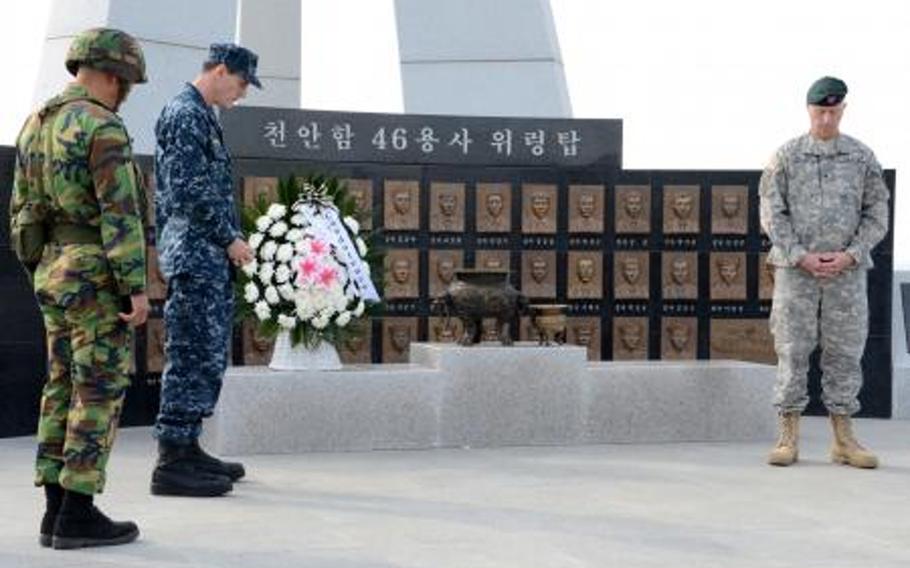
From left, Lt. Col. Cha Jae-Gwan of the Republic of Korea marine corps, U.S. Navy Rear Adm. Bill McQuilkin and Brig. Gen. Neil Tolley, a special operations commander, reflect after laying a wreath at a memorial in October 2011. The Cheonan 46 Warriors Memorial Tower honors South Korean sailors who died in March 2010 when a torpedo, presumably fired by North Korea, sank their ship. South Korea is building a small naval station on the island near where the attack occurred. (Travis Simmons/DVIDS)
SEOUL — South Korea’s efforts to bolster its naval capabilities following a pair of deadly attacks by North Korea got a couple of recent boosts that also could eventually serve the U.S. Navy.
The South’s Supreme Court ruled Thursday that the controversial construction of a naval base on Jeju Island, south of the Korean peninsula, is lawful and may continue.
Meanwhile, government officials announced last week that a naval facility will be built on Baengnyeong Island, one of five islands west of the peninsula and just south of the disputed maritime border with North Korea.
One official with the South Korea Ministry of National Defense said the Baengnyeong facility will enable “a more stable management over the Northern Limit Line” that divides the two Koreas in the Yellow Sea.
Another said that while the facility is not being developed with the U.S. Navy in mind, American vessels might someday use it.
The presence and capabilities of the South Korean and U.S. navies have been a hot-button issue since 2010, when North Korea was blamed for sinking the Cheonan warship, killing 46 South Korean sailors dead, and shelling Yeonpyeong Island near the border, killing four.
South Korean media roundly criticized their military and government for responding with little more than token resistance and rhetoric.
The military was subsequently restructured with creation of the Northwest Islands Defense Command, which reports directly to the chairman of the South’s Joint Chiefs of Staff and is tasked with defending the five westernmost border islands from attacks by the North.
The South has said it also increased its manpower, firepower and equipment on and around the islands.
In 2011, construction began on the previously planned Jeju Multipurpose Port Complex about 55 miles south of the South Korean mainland. The primary announced purposes are to allow the South to better police its sea lanes and respond faster to any acts of aggression by North Korea in waters east or west of the peninsula.
When finished in 2015, the base will be able to accommodate as many as 20 navy ships and submarines, not to mention the occasional cruise ship.
South Korean officials said last year that while the U.S. military would be able to dock ships at Jeju temporarily, the base is being built primarily for Korean ships.
The project has been the target of sometimes-violent protests and a number of court battles instigated by people who believe it will ruin the island’s idyllic reputation and make it a primary target in the event of hostilities in or around Asia. In its decision this week, the Supreme Court overturned a lower-court ruling and said environmental assessments were properly done prior to the start of construction.
The Baengnyeong Island facility reportedly will have accommodations for up to 100 troops and a dock for small warships by the time it is completed in 2014. Ministry of National Defense officials took issue Thursday with those calling it a “naval base.”
“To the public, it might be seen as a base,” one said. “But, it’s more of a mooring facility,” with accommodations for a military company.
Asked if the ministry fears making Baengnyeong Island a potential target for a North Korean attack, another ministry official said, “We have no fear putting it there at all. We’re just building a dock to improve our soldiers’ living conditions.”